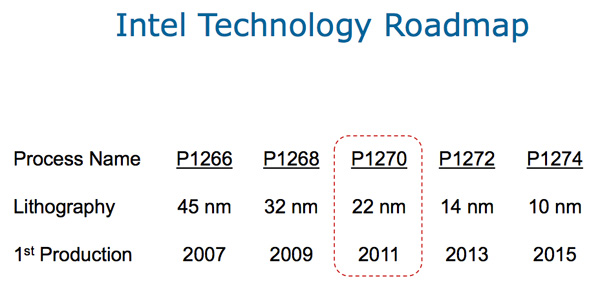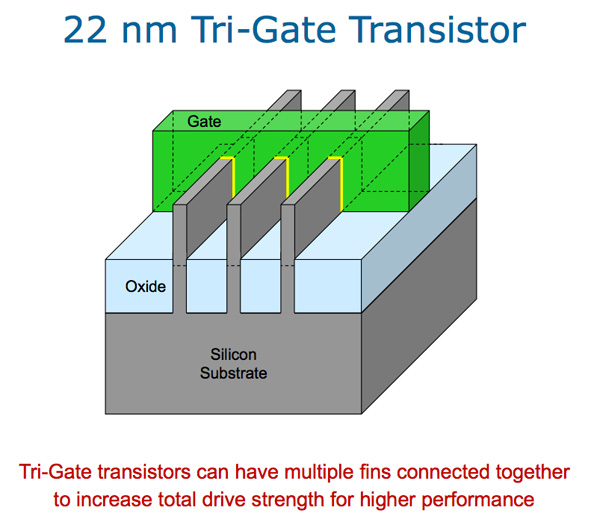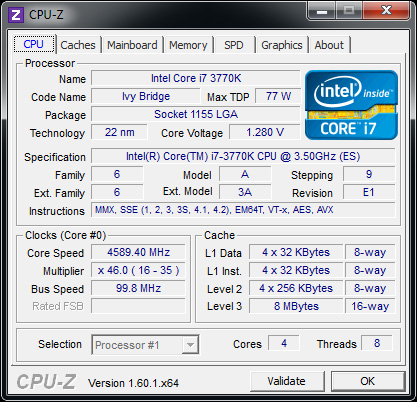The Intel Ivy Bridge (Core i7 3770K) Review
by Anand Lal Shimpi & Ryan Smith on April 23, 2012 12:03 PM EST- Posted in
- CPUs
- Intel
- Ivy Bridge
Overclocking and 22nm
In the old days, whenever Intel transitioned to a new manufacturing process it was accompanied by increased overclocking headroom thanks to the reduction in power consumption and increase in switching speed afforded by the new transistors. To be honest, it's surprising the ride has even lasted this long.

Intel's 22nm process (P1270) is the most ambitious yet. The non-planar "3D" transistors promise to bring a tremendous increase in power efficiency by increasing the surface area of the transistor's inversion layer. It's the vehicle that will bring Intel into new form factors in mobile, but we're around a year away from Haswell's introduction. Rather than 22nm being a delivery platform for Ivy Bridge, it feels like Ivy Bridge is being used to deliver 22nm.

The process is still young and likely biased a bit towards the lower leakage characteristics of lower voltage/lower wattage CPUs, such as those that would be used in Ultrabooks. These two factors combined with some architectural decisions focused on increasing power efficiency result in what many of you may have heard by now: Ivy Bridge won't typically overclock as high as Sandy Bridge on air.
The frequency delta isn't huge. You'll still be able to hit 4.4—4.6GHz without resorting to exotic cooling, but success in the 4.8—5.0GHz range will be limited to water alone for most. Ivy Bridge is also far more sensitive to voltage than Sandy Bridge. Heat dissipation can increase significantly as a function of voltage, so you'll want to stay below 1.3V in your overclocking attempts.
Dr. Ian Cutress, our own Senior Motherboard Editor, put Ivy Bridge through a pretty exhaustive investigation if you want more details on exactly how the chip behaves when overclocking and how best to overclock it.
For the past few years I've been focused on power efficient overclocking. I'm looking for the best gains I can get without significant increases in core voltage. With my 3770K I was able to reliably hit 4.5GHz with only a 140mV increase in core voltage:

The end result is a 15—28% overclock, accompanied by a 32% increase in power consumption. The relationship between overclock speed and power consumption actually hasn't changed since Ivy Bridge, at least based on this datapoint.
| Ivy Bridge Overclocking | |||||
| Intel Core i7 3770K | Stock | 4.6GHz Overclock | % Increase | ||
| Load Power Consumption | 146.4W | 204W | 39.3% | ||
| x264—2nd Pass | 41.8 fps | 49.5 fps | 18.4% | ||
As always, your mileage may vary depending on the particular characteristics of your chip. Ivy Bridge can be overclocked, but at least initially it's not going to be as good of an overclocker as Sandy Bridge. Over time I expect this to improve somewhat as Intel's 22nm process matures, but by how much remains a question to me. It's unclear just how much of these limits are by design vs. a simple matter of process maturity.











173 Comments
View All Comments
aegisofrime - Monday, April 23, 2012 - link
It's interesting to me that this article doesn't include any temperature measurements. I have been hearing that Ivy Bridge has got temperature issues. Could you update the article with those numbers? I'm aware that the article on undervolting and overclocking has some numbers, but none at stock voltage and clocks as far as I know.Stuka87 - Monday, April 23, 2012 - link
I was just going to post the same thing. Where on earth are the temp measurements?Anand Lal Shimpi - Monday, April 23, 2012 - link
Ian's article thoroughly covers the thermal issues, and did include a stock clock graph with voltage scaling:http://images.anandtech.com/doci/5763/Stock%20Spee...
Take care,
Anand
Stuka87 - Tuesday, April 24, 2012 - link
Thanks for responding Anand.The issue I see is in the future, people will look for this review, and not know to look in another article for temp readings.
And I know the other article did have a temp graph, but it did not have the bar graph comparing it to other CPU's like we are used to. I actually have no clue how it compares to a SNB chip after reading this article in terms of temperatures. It would be great to have that information as it aids in building a new system.
Thanks!
samal90 - Monday, April 23, 2012 - link
Okk...so the A8-3870K beats it in almost every gaming benchmark and they are marketing the HD4000....pretty bad for intel. Trinity will completely destroy Ivy bridge then it seems. Every generation, one company is slacking off behind the other...it's always like that. Next year, intel will take the crown..then the year after it will be AMD...and so on.N4g4rok - Monday, April 23, 2012 - link
Not so sure about that actually. I think they're going to fork in two different directions, with Intel being your high compute power desktop friendly option, and AMD being the go to for laptop, notebook, and ultrabook-esque form factors. Unless trinity mucks up big time, AMD will have the IGP thing down. for a while.JarredWalton - Monday, April 23, 2012 - link
I think you're wrong on the "AMD being the go to for laptop..." part. AMD will be the go-to option for people that want an inexpensive laptop with better IGP performance. As I note in the mobile IVB article, mobile Llano GPU performance isn't nearly as impressive relative to IVB as on the desktop. Anyway, AMD will continue to lead on IGP performance with Trinity I'm sure, but there are very large numbers of laptop users that don't even play games. Of course, the highest selling laptops are still going to be the least expensive laptops.DanNeely - Monday, April 23, 2012 - link
For mainstream laptops the real factor is probably going to be battery life. AMD needs to catch up to Intel with power management to get beyond niche products.seasalt - Monday, April 23, 2012 - link
Why is it listed as 77W when the ones already being sold are clearly marked 95W on the boxes?http://www.nordichardware.com/news/69-cpu-chipset/...
mechwarrior1989 - Monday, April 23, 2012 - link
It's in the article..."Note that max TDP for Ivy Bridge on the desktop has been reduced from 95W down to 77W thanks to Intel's 22nm process. The power savings do roughly follow that 18W decrease in TDP. Despite the power reduction, you may see 95W labels on boxes and OEMs are still asked to design for 95W as Ivy Bridge platforms can accept both 77W IVB and 95W Sandy Bridge parts."